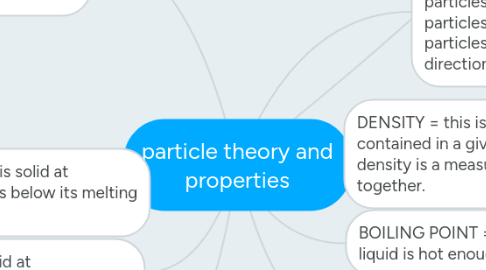particle theory and properties
by Red Hughes

1. a substance is solid at temperatures below its melting point
2. a substance is liquid at temperatures between its melting point and its boiling point
3. a substance is liquid at temperatures above its boiling point
4. gas pressure - when gas particles hit the walls of there container they can cause pressure. the more particles that hit the walls causes higher pressure. if you heat a gas its particles move more quickly and collide with the container walls more with more force, so the pressure increases. the pressure also increases if you have a smaller container size and the particles will collide with the walls more often.
5. diffusion - diffusion is the spreading of particles in a gas or liquid. and example would be pouring a glass of water then adding squash to it, the squash and the water mix together without you physically needing to mix it
6. MELTING POINT = the temperature at which a solid becomes hot enough to melt and become a liquid
7. BOILING POINT = the temperature at which a liquid is hot enough to boil and become a gas.
8. DENSITY = this is a measure of how much mass of a substance is contained in a given unit of volume (density = mass/volume) . density is a measure of how tightly the particles are packed together.
9. expansion - substances expand when they are heated and contract when they are cooled down. this can be both helpful and hindering. when substances expand their particles stay the same size but the space between the particles changes as the particles move about more. in solids the particles vibrate more, in liquids the particles move around each other more, in gases the particles move faster in any direction.


